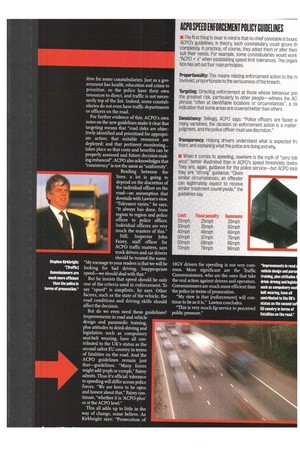ACP° SPEED ENFORCEMENT POLICY GUIDELINES
Page 63

If you've noticed an error in this article please click here to report it so we can fix it.
The first thing to bear in mind is that no chief constable is bounc AOPO's guidelines; in theory, each constabulary could ignore th completely. In practice, of course, they adopt them or alter their suit their needs. For example, some constabularies would work "AOPO + x" when establishing speed limit tolerances. The organi tion has set out four main principles.
Proportionality: This means relating enforcement action to the ri: involved, proportionate to the seriousness of the breach.
Targeting: Directing enforcement at those whose behaviour poE the greatest risk, particularly to other people—witness the AO phrase "often at identifiable locations or circumstances", a CIE indication that some areas are covered better than others.
Consistency: Tellingly, ACP° says: "Police officers are faced w many variables; the decision on enforcement action is a matter judgment, and the police officer must use discretion."
Transparency: Helping drivers understand what is expected frc them, and explaining what the police are doing and why.
II When it comes to speeding, nowhere is the myth of "zero tolE
ance" better illustrated than in ACPO's speed thresholds (belov
They are, again, guidance for the police service—but ACP() insiE they are "strong" guidance: "Given similar circumstances, an offender can legitimately expect to receive similar treatment countrywide," the guidelines say.




























































































































